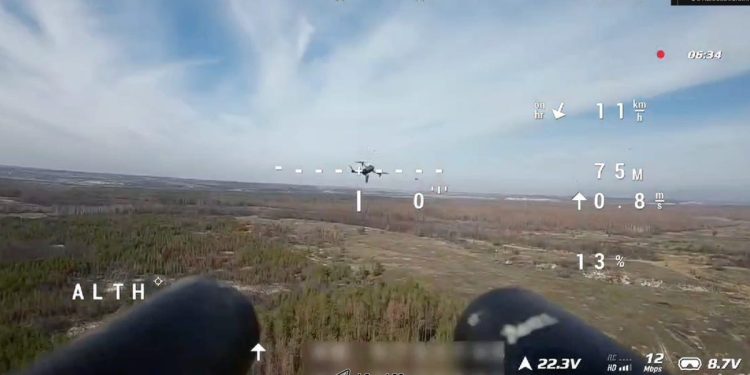Helices turning on the landscape loaded with Frost, the Ukrainian drone approaches, twin tons crawling towards the enemy bomber.
A flash breaks out on her camera in the first person attached, and the target – a Dji Mavic drone – falls lifeless on the ground.
Dozens of other attacks play in rapid succession, each showing the ends of two barrels which explode the Mavics of the sky.
The video was published on Sunday by the 2nd motorized battalion of the 30th mechanized brigade of Ukraine, which fights near Bakhmut. His legend that accompanied him was simple. “The drop in enemy drones is one of the priorities of the 2nd battalion of the 30th mechanized brigade,” wrote the battalion on its telegram channel.
These clips are part of one of the largest recorded collections made public of a relatively new concept in action – drones slaughtering other drones.
Practice also has implications for the way in which the technology of battlefields evolves more widely in the war, because the Ukrainian and Russian units have experienced the fixing of firearms and even the thermite melted in drones, essentially creating flying pistols and flame speeds.
In Sunday, the double barillad rifle drone has mainly targeted which seems to be mavics. These light Chinese sales drones are expensive and, therefore, generally reserved for screening or bombing missions by both sides.
Inspiration of the First World War
The presidential brigade of Ukraine, which has combat units in Luhansk, published an identical creation to the hunting rifle drone in early March.
Images have shown a hindsight pistol concept, where a quadcopter is equipped with long barrels designed to draw from both ends. One side aims at the target, while the opposite end draws to provide a counter-reflect and maintain the stable drone.
“The impact factor is strong. You don’t need precision; the propagation effect is what matters,” said a member of the camera brigade.
The brigade has published a clip of the drone pulling on a target card, its roaring twins. Since the drone has not been seen with a recharging mechanism, the hunting rifle will probably have to come back for manual recharging.
The same idea was observed in Ukraine at the end of December, when a Ukrainian charitable organization, Lesiaua, published clips of what he said to be drones mounted on rifles he had helped to finance. Visually, the drone seems to be the same type as the 30th mechanized brigade.
Russian drone manufacturers had already tested the concept in September. Ria Novosti of the State Media published an article this month covering the design of a single barrel mounted on a drone which could draw simultaneously in both directions.
“It operates on the principle of Canon Davis Aircraft of the First World War,” wrote the point of sale.
Designed from experiences of the US Navy Commander Cleland Davis in 1910, the pistol provided soldiers with a way to reduce the decline but was heavy to recharge. He saw limited use during the First World War.
The development of drones evolves rapidly in Ukraine largely due to the decentralized nature of the industry. Volunteers, units and manufacturers generally work on individual projects and promote them.
Many creations, such as optical fiber drones, have increasingly presented the inherited technology used to beat more modern equipment. In the West, he aroused concerns among certain defense analysts that the NATO industrial military complex has focused too much on the development of advanced weapons, without considering the need for quantity or the possibility of low -technology solutions.
businessinsider


